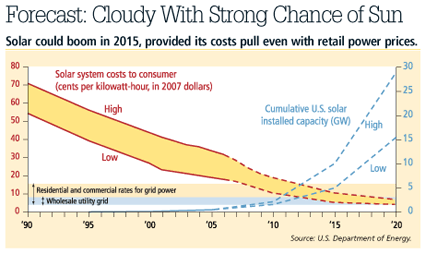RÉSEAU SOL(ID)AIRE DES ÉNERGIES !
RISING SUN
The Sunshine Economy
ADIT, août 2007, http://www.forbes.com
| Solar
power is the ultimate alchemy, using something free to create something
valuable.
Aficionados like to point out that an hour of sunlight packs enough energy to power the entire world for a day. Or this: If you could cover an area about the size of Massachusetts in the Southwest U.S. entirely with solar cells, you could generate enough electricity to quench America's need for electric power. But building solar cells, the devices that convert photons from the sun into streams of electrons and electricity, is complex, expensive magic to pull off--and has burned many entrepreneurs and investors in the past. Today, solar energy contributes about a tenth of a percent (0.1%) of the U.S.'s electricity needs. Both Germany and Japan, where government have provided more subsidies, use a larger percentage of solar power. But oh, the promise. Among alternative energies, solar energy is a child starlet: alluringly clean, endlessly promising--yet petulantly expensive and hard to manage. For investors, solar energy stocks have been an astonishing story this year: The aggregate market value of a group of 28 solar companies now tops $118 billion. On average, the value of those companies has risen almost by half since January. Driving those market valuations is the expectation of more growth ahead: Analysts both in industry and in the government anticipate that solar will be the fastest-growing alternative source of electric power over the next 25 years. How will it happen? This year's E-gang, our ninth annual look at technology innovation, offers a snapshot of some of the inventions and entrepreneurs that are part of this solar boom. The work starts with tool makers--those companies that are building and refining the equipment needed to make solar cells. Then there are inventors, who keep trying to squeeze more power from every ray of sunlight. Manufacturers of different versions of solar power vie to have their approach designated as the most promising. There are plenty of contestants: the traditional approach of building crystalline solar cells, pairs relatively higher efficiency with higher costs. There are thin-films of solar materials, some made from exotic combinations of materials, others still relying on silicon. Then there is one of the oldest ways of getting power out from the sun: solar "thermal" installations, which absorb the sun's energy, transforming it into heat so it can boil water and run a turbine. Finally there are those who innovate through their business models and strategic approach--the installers turned financiers, who help customers juggle the costs and risks of investing in solar. None have had more experience in this than Germany's solar installers, who are cashing in on their government's generous subsidies for solar power. The stock market has also been a boon to many Chinese companies, which have jumped into the business of building everything from solar wafers to finished panels. Investors have been snapping up stocks of solar companies from around the world. The aggregate market valuation of these 28 solar products manufacturers in early August was $118 billion:
Sources: Bloomberg Financial Markets; FT Interactive, Reuters Fundamentals and Worldscope via FactSet Research Systems; U.S. Department of Energy. Sources: Bloomberg Financial Markets; FT Interactive, Reuters Fundamentals and Worldscope via FactSet Research Systems; U.S. Department of Energy. Sources: Bloomberg Financial Markets; FT Interactive, Reuters Fundamentals and Worldscope via FactSet Research Systems; U.S. Department of Energy. Solar power is still more expensive than fossil fuel generated electricity. But the gap is closing. The rule of thumb in the solar business: Every time the volume of solar cells doubles, its cost drops by 20%:  According to the International Energy Agency, by the end of 2005 Germany led the world with the most installed photovoltaic systems (1.43 million kilowatts) followed by Japan (1.42 million kilowatts). The U.S. was a distant third (480,000 kilowatts). (Click here for more information.) The race is on to find a way to make solar grow up so that it can compete, dollar-per-watt, against any fuel on the planet. The long-term forecast? Bright, with big patches of innovation ahead. |
||||||||||||||||||||||||||||||||||||||||||||||||||||||||||||||